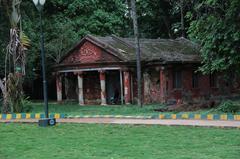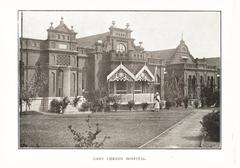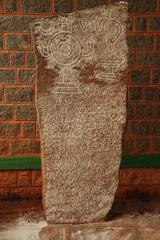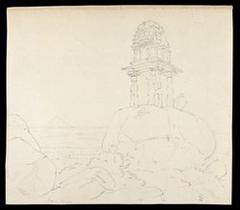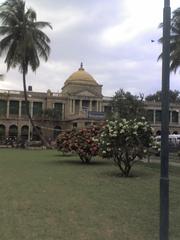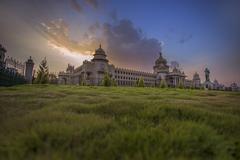
Comprehensive Guide to Visiting Lal Bagh, Bengaluru, India
Date: 16/08/2024
Introduction
Lal Bagh Botanical Garden, a prominent landmark in Bengaluru, India, is not just a sprawling green space but a living museum of natural history and cultural heritage. Established in the 18th century by Hyder Ali and later expanded by his son Tipu Sultan, Lal Bagh has grown into a 240-acre treasure trove of botanical diversity and historical significance. The garden’s design was inspired by the grandeur of Mughal Gardens, reflecting the rulers’ appreciation for intricate landscape architecture (Solopassport). Over the centuries, Lal Bagh has evolved under various influences, including significant contributions during the British colonial period, which saw the addition of the iconic Glass House modeled after London’s Crystal Palace (News9Live). Today, it remains a vibrant hub for botanical research, conservation, and cultural events, attracting millions of visitors annually (Traveller Scribe). This guide offers an in-depth exploration of Lal Bagh, covering its rich history, ecological significance, visitor information, and tips for making the most of your visit.
Table of Contents
- Introduction
- History of Lal Bagh Botanical Garden
- Conservation and Education
- Modern-Day Lal Bagh
- Conclusion
- Sources
History of Lal Bagh Botanical Garden
Origins and Establishment
Lal Bagh Botanical Garden, located in Bengaluru, India, has a rich history that dates back to the 18th century. The garden was commissioned by Hyder Ali, the ruler of Mysore, in 1760. Hyder Ali was inspired by the Mughal Gardens, which were renowned for their grandeur and intricate designs. He envisioned creating a similar garden in Bengaluru, reflecting the Mughal influence on his taste (Wikipedia).
Hyder Ali’s vision was brought to fruition by his son, Tipu Sultan, who completed the garden. Tipu Sultan added horticultural wealth to Lal Bagh by importing trees and plants from various countries, enhancing its botanical diversity (Bangalore Vibe). The garden was initially spread over 30 acres but has since expanded to cover 240 acres, making it one of the largest botanical gardens in India (Solopassport).
British Influence and Expansion
After the fall of Tipu Sultan in 1799, Lal Bagh came under British control. The British recognized the garden’s potential and continued to develop it. They appointed numerous superintendents who were responsible for its maintenance and expansion. One of the most notable contributions during the British era was the construction of the Glass House in 1890, modeled after the Crystal Palace in London. This structure became the centerpiece for the biannual flower shows held during Republic Day and Independence Day (News9Live).
Architectural and Horticultural Marvels
Lal Bagh is not just a botanical garden but also a site of historical and architectural significance. The garden houses several landmarks, including the Kempegowda Tower, built by Kempe Gowda II, the founder of Bengaluru. This watchtower, located on a large rock within the garden, offers panoramic views of the city (LBB).
The garden also features the Lalbagh Rock, one of the oldest rock formations on Earth, estimated to be over 3,000 million years old. This geological marvel attracts geologists and tourists alike, adding to the garden’s historical allure (SOTC).
Conservation and Education
Lal Bagh has played a crucial role in the conservation and propagation of various plant species. The garden is home to over 1,854 species of plants, including rare and exotic varieties. It has India’s largest collection of tropical and sub-tropical plants, making it a significant center for botanical research and education (Traveller Scribe).
The garden’s commitment to conservation is evident through its ongoing efforts to preserve its biodiversity. Environmentalists, botanists, and the local community work together to safeguard this ecological treasure. Lal Bagh also hosts horticulture workshops, cultural festivals, and exhibitions throughout the year, promoting environmental awareness and education (Tusk Travel).
Flower Shows and Cultural Significance
One of the most celebrated events at Lal Bagh is the biannual flower show, held during Republic Day in January and Independence Day in August. These flower shows are a riot of colors, featuring a dazzling array of flowers arranged in intricate designs. The Glass House serves as the main venue for these exhibitions, attracting thousands of visitors from around the world (Travel Twosome).
The flower shows also include competitions such as Ikebana, fruit carving, and Bonsai displays, engaging attendees and showcasing the horticultural talents of participants. These events not only highlight the garden’s floral diversity but also celebrate India’s cultural heritage (News9Live).
Modern-Day Lal Bagh
Visitor Information
For those planning to visit Lal Bagh, the garden is open daily from 6:00 AM to 7:00 PM. Entry is free during early morning and late evening hours (6:00 AM to 9:00 AM and 6:00 PM to 7:00 PM). At other times, an entry fee of INR 30 is charged. The best way to reach Lal Bagh is by Namma Metro, with a station conveniently located next to the park (LBB).
Visitors can explore various attractions within the garden, including the Bonsai Garden, Hibiscus Garden, and the Lotus Pond. The garden also offers guided tree walks, workshops, and conservation efforts, allowing visitors to engage deeply with its botanical and historical treasures (Tusk Travel).
Travel Tips and Nearby Attractions
Lal Bagh is easily accessible via Namma Metro. Nearby, visitors can explore other attractions such as the Bangalore Palace and Cubbon Park. Ensure to carry water, wear comfortable shoes, and plan your visit during the flower shows for a memorable experience.
FAQ
Q: What are the visiting hours for Lal Bagh Botanical Garden? A: Lal Bagh is open daily from 6:00 AM to 7:00 PM.
Q: Is there an entry fee? A: Entry is free during early morning and late evening hours (6:00 AM to 9:00 AM and 6:00 PM to 7:00 PM). At other times, there is an entry fee of INR 30.
Conclusion
Lal Bagh Botanical Garden stands as a testament to the vision of its founders and the dedication of those who have nurtured it over centuries. From its origins under Hyder Ali and Tipu Sultan to its expansion and enhancement during the British era, Lal Bagh has continuously evolved while preserving its rich botanical heritage. Today, the garden is not just a haven for nature lovers but also a center for education, conservation, and cultural celebration. Its biannual flower shows, historical monuments, and diverse plant species offer a unique blend of natural beauty and historical intrigue, making it a must-visit destination in Bengaluru (Tusk Travel). Whether you’re a history buff, a nature enthusiast, or simply looking for a serene escape from urban life, Lal Bagh provides a multifaceted experience that is both enriching and rejuvenating. Plan your visit to this iconic garden and immerse yourself in its myriad attractions for a truly memorable experience (Bengaluru Prayana).
Sources
- Wikipedia. (n.d.). Lal Bagh. Wikipedia. source
- Bangalore Vibe. (n.d.). Lal Bagh’s hidden treasures: Discovering the secrets of Bengaluru’s botanical jewel. Bangalore Vibe. source
- Solopassport. (n.d.). Lal Bagh. Solopassport. source
- News9Live. (n.d.). Bengaluru’s Lal Bagh flower show 2024 to continue till August 19: Timings, ticket prices, other details. News9Live. source
- LBB. (n.d.). Lal Bagh Botanical Garden, Bangalore. LBB. source
- SOTC. (n.d.). Everything you need to know about the Bangalore Lal Bagh Garden. SOTC. source
- Traveller Scribe. (n.d.). Lal Bagh Botanical Garden, Bangalore. Traveller Scribe. source
- Tusk Travel. (n.d.). Lal Bagh Botanical Garden Bangalore: Your ultimate exploration guide. Tusk Travel. source
- Travel Twosome. (n.d.). Lovely Lal Bagh flower show. Travel Twosome. source
- Bengaluru Prayana. (n.d.). Lal Bagh Botanical Garden, Bangalore. Bengaluru Prayana. source
- Karnataka.com. (n.d.). Lal Bagh. Karnataka.com. source
- Travel2Karnataka. (n.d.). Lal Bagh. Travel2Karnataka. source
